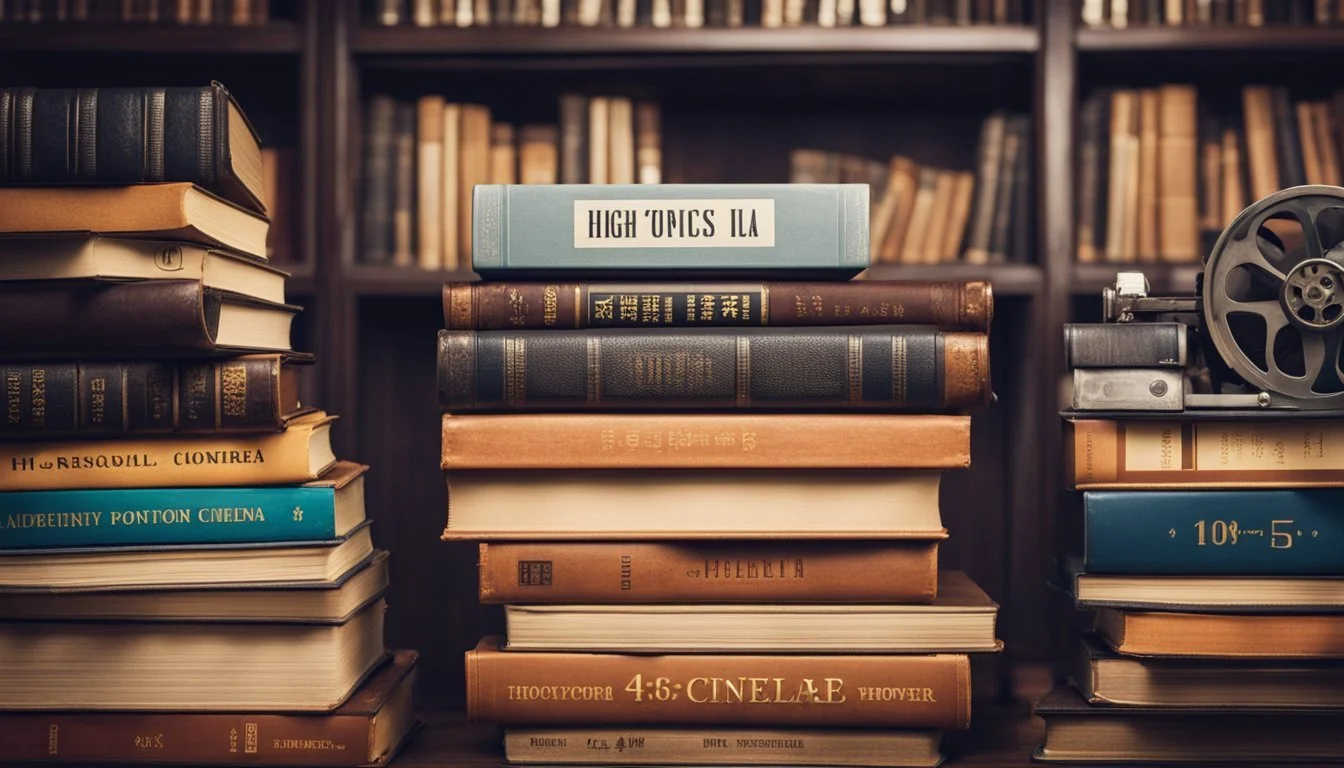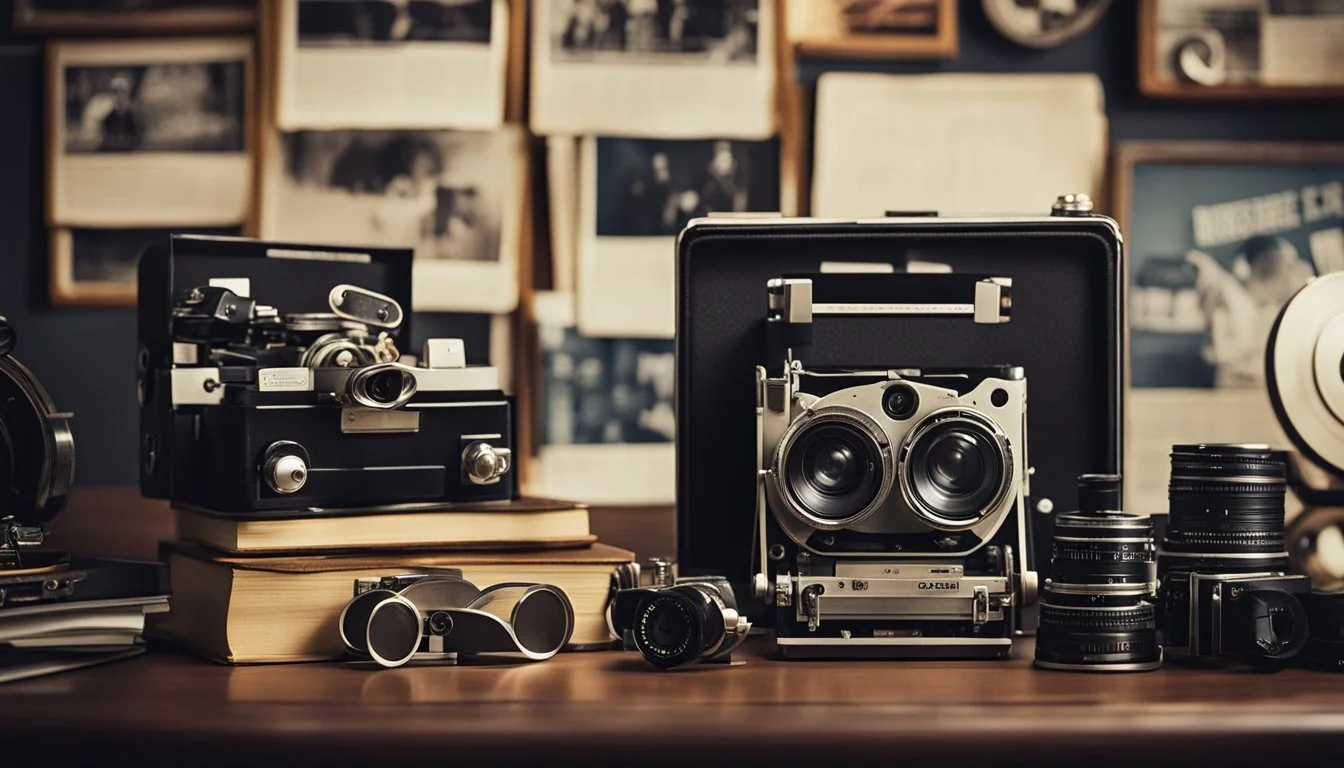11 Must-Read Books About the History of Cinema
Essential Guides for Film Enthusiasts
Cinema has a rich and varied history, offering insights into cultural shifts, technological advances, and artistic milestones. The study of cinema's history provides not only entertainment but also a deeper appreciation for the medium's evolution and its impact on society.
Books on the history of cinema serve as essential resources for anyone interested in understanding the development of film as an art form and industry. From classic texts to modern analyses, these works offer valuable perspectives that enrich the reader's knowledge and appreciation of cinema's transformative journey.
1) The Story of Film by Mark Cousins
The Story of Film by Mark Cousins offers an insightful exploration into the history of cinema. Recognized for its accessibility, this book serves as a companion to Cousins' 15-hour documentary, "The Story of Film: An Odyssey."
Filmmaker and author Mark Cousins delves into how historical events and mutual influences among filmmakers shape cinema.
This updated edition includes new chapters, enhancing its comprehensive coverage. Cousins' narrative weaves film technology, production, and groundbreaking scenes, making it a valuable resource for understanding cinematic trends.
Through examples like Douglas Sirk's Hollywood melodramas, Cousins illustrates the profound impact of filmmakers on each other and the art form. This book is a must-read for anyone interested in cinema history.
2) Cinema Studies: The Key Concepts by Susan Hayward
"Cinema Studies: The Key Concepts" by Susan Hayward is an essential resource in the field of film studies. It provides clear and accessible explanations of a wide range of genres, movements, and theories central to understanding cinema.
The book covers an extensive array of topics, making it an invaluable guide for students and educators. Its entries include important production terms that are fundamental to the study and appreciation of film.
Updated thoroughly, this guide reflects current changes and trends in the industry. From streaming to environmental impacts, Hayward's latest edition includes topical entries that address contemporary issues in cinema.
Her work is often recognized for its meticulous research and comprehensive approach. It serves not just as an introductory text but also as a detailed reference for more advanced learners.
3) Hitchcock/Truffaut by François Truffaut
Hitchcock/Truffaut by François Truffaut is a cornerstone in cinema literature. The book, first published in 1966, is a detailed dialog between two legendary directors, Alfred Hitchcock and François Truffaut.
This work is based on a week-long conversation held in 1962 at Universal Studios. During this time, Truffaut and Hitchcock discussed Hitchcock's entire career, offering insights into his methods and storytelling prowess.
The book offers a unique perspective as it captures the insights from both directors' experiences. Truffaut, a respected filmmaker himself, brings in-depth questions that elicit meaningful responses from Hitchcock about his creative process.
It covers Hitchcock's journey from his early days in Britain's silent film era to his iconic status in Hollywood. This meticulous walk-through of Hitchcock's filmography provides readers with an educational and engaging narrative.
Readers will find value not only in the technical discussions but also in the personal anecdotes and reflections shared by Hitchcock. The book's conversational style makes it accessible and enjoyable for both cinema enthusiasts and scholars alike.
By diving into Hitchcock's mind, the book sheds light on both the art and craft of filmmaking.
This text remains an essential read for those who appreciate classic cinema and want to gain a deeper understanding of Hitchcock's significant contributions to the medium.
4) Rebel Without a Crew by Robert Rodriguez
"Rebel Without a Crew" by Robert Rodriguez is an insightful look into the world of independent filmmaking. Written in a diary format, the book reveals the innovative strategies Rodriguez employed to create his debut film "El Mariachi" on a limited budget of $7,000.
The author shares his journey from an unknown filmmaker to a Hollywood director. This transition began with participating in a medical study to fund "El Mariachi." Through persistence and creativity, Rodriguez managed to deliver a compelling film that caught the industry's attention.
Rodriguez's narrative is both instructional and motivational. He breaks down the technical aspects of filmmaking, offering practical advice for aspiring directors. His hands-on approach and resourcefulness highlight that passion and ingenuity can surmount financial limitations in filmmaking.
For those interested in the mechanics of low-budget filmmaking, this book serves as a practical guide. It also serves as inspiration, demonstrating how unconventional methods can lead to success in the competitive world of cinema.
5) The Film Book by Ronald Bergan
"The Film Book" by Ronald Bergan serves as an extensive guide to the world of cinema. It provides an in-depth exploration that caters to both casual movie lovers and avid film buffs. The book is well-structured, dividing its content into several insightful chapters.
The book covers the history of film from its inception in 1895 to the present day. This historical timeline allows readers to understand the evolution of filmmaking over the years.
In addition to history, the book explains the various roles in cinema, from directors and actors to behind-the-scenes roles like screenwriters and editors. Each role is discussed to give a comprehensive understanding of film production.
Genres are also examined in detail. The book explores different genres of cinema, helping readers appreciate the diversity and creativity within the film industry. Additionally, it also delves into the contributions of different countries to the film world.
Lastly, "The Film Book" includes profiles of influential directors. These profiles help readers to understand the individual styles and contributions of key figures who have shaped the film industry. The book serves as a treasure trove of cinematic knowledge, appealing to anyone with an interest in film.
6) On Directing Film by David Mamet
David Mamet, a Pulitzer Prize-winning writer, is known for his work in both theater and film. "On Directing Film" offers an insightful look into his approach to directing.
Mamet's work emphasizes simplicity and clarity. He believes in focusing on the essentials of storytelling rather than getting lost in technicalities.
The book draws on his experiences with films like "House of Games" and "State and Main." Mamet uses these examples to illustrate his points, making his arguments concrete and relatable.
Mamet's style is direct and often blunt. He avoids flowery language and instead opts for practical advice. This makes his book accessible to both newcomers and experienced filmmakers.
7) The New Wave: Truffaut, Godard, Chabrol, Rohmer, Rivette by James Monaco
James Monaco's "The New Wave: Truffaut, Godard, Chabrol, Rohmer, Rivette" explores one of the most influential movements in cinema history.
The book examines the French New Wave and its five pioneering directors: François Truffaut, Jean-Luc Godard, Claude Chabrol, Éric Rohmer, and Jacques Rivette. This era marked a revolutionary shift in filmmaking during the late 1950s and 1960s.
Monaco is thorough in his analysis, offering detailed notes and over fifty stills that capture the essence of this vibrant period. It's a resource valued by both academics and cinema enthusiasts.
The Thirtieth Anniversary Edition of the book includes new insights, reflecting on the enduring impact of these directors. Monaco's expertise is evident as he connects their contributions to the broader context of film history.
Each director's journey from critics to filmmakers is highlighted, demonstrating how their work at "Cinematheque Francaise" was foundational. Their innovative techniques and storytelling methods reshaped modern cinema's direction and content.
Monaco’s work is essential for anyone interested in understanding the transition from traditional to modern film storytelling. His blend of factual study and visual documentation provides a comprehensive look at the French New Wave's legacy.
8) The Complete History of American Film Criticism by Jerry Roberts
Released in 2010, "The Complete History of American Film Criticism" by Jerry Roberts is a detailed chronicle of American film critics and their influence over the past century.
The book starts with the first movie review published in the New York Times in 1896. Roberts meticulously traces the evolution of film criticism through various eras.
Each section highlights key figures and their contributions, from the Silent Era to the Golden Age of the 1970s.
Roberts also covers the rise and impact of film critics during the Film Generation of the 1960s.
His work includes biographical sketches, providing insight into the lives of influential critics.
Roberts discusses the shifts in the field, addressing both the accomplishments and controversies. This book serves as a vital resource for understanding the development of American film criticism.
"The Complete History of American Film Criticism" offers readers a comprehensive look at how critics have shaped the film industry and public opinion.
9) Film Form: Essays in Film Theory by Sergei Eisenstein
Sergei Eisenstein's "Film Form: Essays in Film Theory" serves as a cornerstone for anyone interested in the intricacies of cinema. The book compiles twelve essays written between 1928 and 1945, establishing key points in the evolution of Eisenstein's groundbreaking film theories.
Eisenstein explores a range of topics, including the transition from theater to cinema and the concept of cinematic montage. His work delves into the use of the "ideogram" and its significance in film. Each essay offers a unique perspective on the filmmaking process.
The collection is recognized for its analysis of the sound-film medium and its impact on cinematic storytelling. Eisenstein's thoughts on "The Filmic Fourth Dimension" and "Methods of Montage" illustrate his innovative approach. These essays remain relevant for their in-depth examination of film form and technique.
Eisenstein's legacy in the history of cinema is further cemented by this collection. Known for directing classics like "Battleship Potemkin," his theoretical writings complement his practical work. "Film Form: Essays in Film Theory" not only showcases his intellectual rigor but also continues to influence filmmakers and scholars today.
10) The Oxford History of World Cinema by Geoffrey Nowell-Smith
Geoffrey Nowell-Smith's "The Oxford History of World Cinema" stands as an authoritative volume in the study of cinema history.
This comprehensive book delves into cinema's evolution, encompassing various movements, genres, and key filmmakers from around the globe.
Readers will find detailed essays on early cinema, classic Hollywood, film noir, European art cinema, and more.
The text also highlights cinema's cultural impact, technological advancements, and the industry's economic growth.
Illustrated with stills and posters, the book offers visual appeal alongside its in-depth analysis.
Cinephiles and scholars alike appreciate the engaging writing style and the extensive research evident throughout the pages.
Published by Oxford University Press, this book is a valuable resource for anyone interested in the rich history of the film industry.
With over 800 pages, it is a substantial addition to any film studies library.
11) Scorsese on Scorsese by Martin Scorsese
"Scorsese on Scorsese" is an essential book for those interested in the art of cinema, directed by one of the industry's most influential figures. Martin Scorsese offers a deep dive into his filmmaking process and his remarkable career.
Consisting of career-length interviews, the book features Scorsese's reflections on key films like "Mean Streets," "Taxi Driver," "Raging Bull," and "Goodfellas." These insights reveal the thoughts and inspirations behind some of his most iconic works.
Updated to include newer projects such as "Kundun," "Bringing Out the Dead," and "Gangs of New York," the book remains an up-to-date resource on Scorsese’s contributions to film. It also discusses his documentaries, offering a comprehensive view of his diverse body of work.
Written in collaboration with David Thompson and Ian Christie, "Scorsese on Scorsese" presents an intimate portrait of the director. It highlights his passion for cinema and his unique approach to storytelling, anchored in his upbringing in New York's Little Italy.
For any cinema enthusiast or aspiring filmmaker, this book provides invaluable lessons and a behind-the-scenes look at the creative mind of Martin Scorsese.
Significant Eras in Cinema History
Cinema has undergone significant transformations, marked by key periods that defined its evolution. Each era brought with it technological advancements, stylistic changes, and influential filmmakers.
Silent Film Era
The Silent Film Era, spanning from the late 19th century to the late 1920s, was the foundational period of cinema. In this era, films were produced without synchronized recorded sound, relying heavily on visual storytelling, expressive acting, and live musical accompaniment.
Key filmmakers like D.W. Griffith and Charlie Chaplin revolutionized film techniques, introducing close-ups, cross-cutting, and comedic timing. Iconic films such as "The Birth of a Nation" and "The Kid" emerged, showcasing innovative narrative forms.
This era also saw the birth of various film movements. German Expressionism, with its bold visual style and dramatic themes, had a significant influence. Meanwhile, Soviet Montage Theory, led by Sergei Eisenstein, emphasized editing’s power to evoke emotions and ideas.
Golden Age of Hollywood
The Golden Age of Hollywood, roughly from the 1930s to the 1950s, was characterized by the dominance of major studios like MGM, Warner Bros., and Paramount. This era introduced the studio system, where stars and filmmakers were under long-term contracts, allowing studios to control all aspects of production and distribution.
Major genres flourished, including musicals, westerns, and noir films. Directors like Alfred Hitchcock and John Ford became household names. The era’s landmark films, such as "Gone with the Wind" and "Casablanca," set high standards for storytelling and production values.
Technological advancements played a crucial role. The introduction of Technicolor and widescreen formats enhanced visual appeal. The transition from silent films to talkies revolutionized the industry, bringing sound into the forefront of cinematic experience.
New Hollywood Movement
The New Hollywood Movement, emerging in the late 1960s and extending into the early 1980s, marked a radical shift in filmmaking. This period saw the breakdown of the studio system, giving directors more creative freedom and leading to the production of more innovative and personal films.
Key figures included Martin Scorsese, Steven Spielberg, and Francis Ford Coppola. Films like "Taxi Driver," "Jaws," and "The Godfather" defined this era with their bold narratives and stylistic innovations.
This movement also saw the rise of auteur theory, emphasizing the director’s role as the film's chief creative force. Changes in distribution, such as the rise of multiplexes and the blockbuster model, also began to shape the industry during this period.
Influential Directors and Their Contributions
This section explores the impact of three legendary directors whose unique styles and innovative techniques have left an indelible mark on cinema history. It offers insights into their notable works and lasting contributions.
Orson Welles
Orson Welles revolutionized filmmaking with his groundbreaking debut, Citizen Kane. Citizen Kane is frequently cited as one of the greatest films ever made. Welles's use of deep focus, nonlinear storytelling, and innovative camera techniques transformed cinematic language. Beyond Citizen Kane, he directed The Magnificent Ambersons and Touch of Evil, showcasing his mastery in narrative complexity and atmospheric tension.
His influence extends to his acting and producing roles, often blurring the lines between genres. Welles was known for his bold artistic vision and was a respected figure in film and theatre. His work remains a subject of study in film schools worldwide, illustrating the timeless nature of his cinematic contributions.
Alfred Hitchcock
Alfred Hitchcock, the "Master of Suspense," pioneered the psychological thriller genre. His meticulous attention to detail in films like Psycho and Vertigo introduced audiences to a new level of tension and suspense. Hitchcock's ability to manipulate viewer emotions through technical precision and storytelling craftsmanship is unparalleled.
Hitchcock’s innovative techniques included the use of MacGuffins (plot devices that drive the story), and groundbreaking camera movements to heighten suspense. His signature cameo appearances and his knack for building tension through subtle visual and auditory cues have left a lasting legacy. His works continue to influence modern directors and thrillers, cementing his place in cinematic history.
Akira Kurosawa
Akira Kurosawa’s films have had a profound impact on both Eastern and Western cinema. Known for epic films such as Seven Samurai and Rashomon, Kurosawa’s storytelling techniques and visual style bridged cultural gaps. His use of weather elements and detailed character development created richly immersive experiences.
Kurosawa introduced the use of telephoto lenses for dynamic motion, revolutionizing action sequences. The nonlinear narrative of Rashomon influenced countless films and storytelling methods. Kurosawa’s cross-cultural adaptations, like Throne of Blood (a Japanese adaptation of Shakespeare's Macbeth), demonstrated the universal appeal of his work. His contributions continue to inspire filmmakers globally, validating his status as a cinematic icon.
Impact of Technological Advancements
Technological advancements have significantly shaped the history of cinema, introducing sound, color, and digital transformations that changed how films are made and experienced. Each innovation brought new storytelling possibilities and enhanced viewer engagement.
Introduction of Sound
The introduction of sound revolutionized cinema in the late 1920s. Silent films, once the norm, were replaced by "talkies," starting with 1927's The Jazz Singer. This shift enabled filmmakers to incorporate dialogue, music, and sound effects, adding new dimensions to storytelling.
Sound technology enhanced film genres. Musicals, in particular, flourished. Audiences experienced synchronized soundscapes, helping to create a more immersive and emotional viewing experience. Dubbing and subtitling technologies allowed films to transcend language barriers, broadening their reach globally.
Color Film Revolution
Color film began gaining traction in the 1930s with the development of Technicolor. Films like The Wizard of Oz (1939) showcased vibrant hues, capturing viewers' imaginations. This technology replaced black-and-white film, offering greater visual realism and artistic expression.
The transition to color required significant adjustments in lighting, makeup, and set design. Directors and cinematographers could now use color palettes to evoke mood and symbolically enhance narratives. This technological breakthrough attracted larger audiences and elevated cinema's appeal as a popular art form.
Digital Revolution
The digital revolution transformed film production and distribution. Starting in the late 20th century, digital cameras and editing software made filmmaking more accessible and cost-effective. Notable digital pioneers include George Lucas, who utilized digital technology extensively in Star Wars: Episode I – The Phantom Menace (1999).
Digital projection and streaming platforms revolutionized how audiences accessed films. High-definition and 3D technologies improved viewing experiences. Special effects, animation, and CGI reached new heights, allowing filmmakers to create visually stunning and imaginative worlds that were previously impossible.
The impact of digital technology continues to shape the industry, influencing everything from indie films to blockbuster franchises.












